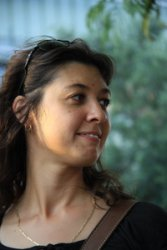CAZypedia needs your help! We have many unassigned GH, PL, CE, AA, GT, and CBM pages in need of Authors and Responsible Curators.
Scientists at all career stages, including students, are welcome to contribute to CAZypedia. Read more here, and in the 10th anniversary article in Glycobiology.
New to the CAZy classification? Read this first.
*
Consider attending the 15th Carbohydrate Bioengineering Meeting in Ghent, 5-8 May 2024.
Difference between revisions of "User:Marie-Line Garron"
Harry Brumer (talk | contribs) m (Text replacement - "\^\^\^(.*)\^\^\^" to "$1") |
|||
| Line 2: | Line 2: | ||
After a Ph.D. obtained in 2007 from the University of Montpellier (France), I joined Mirek Cygler's group, as postdoctoral student, at the Biotechnological Reasearch Institut (Montreal, QC, Canada). My postdoctoral research focused on the structure and function of CAZymes involved in synthesis and degradation of glycosaminoglycans (GAGs), and in particular on Polysaccharide Lyases on which I wrote two reviews. | After a Ph.D. obtained in 2007 from the University of Montpellier (France), I joined Mirek Cygler's group, as postdoctoral student, at the Biotechnological Reasearch Institut (Montreal, QC, Canada). My postdoctoral research focused on the structure and function of CAZymes involved in synthesis and degradation of glycosaminoglycans (GAGs), and in particular on Polysaccharide Lyases on which I wrote two reviews. | ||
| − | In 2010, I joined the glycogenomic group, led by | + | In 2010, I joined the glycogenomic group, led by [[User:Bernard Henrissat|Bernard Henrissat]] at [http://www.afmb.univ-mrs.fr/ AFMB] laboratory (Marseille, France), as postdoctoral researcher in charge of strengthening the functional and structural side of the team. I then obtained a permanent position as Assistant Professor in [https://www.univ-amu.fr/ Aix-Marseille University] in 2011. |
I currently manage the updates of structural and functional information in the [http://www.cazy.org/ CAZy database]. My personal research interests are with the biochemical and structural characterization of distant members of CAZy families and with the discovery of new CAZymes families. | I currently manage the updates of structural and functional information in the [http://www.cazy.org/ CAZy database]. My personal research interests are with the biochemical and structural characterization of distant members of CAZy families and with the discovery of new CAZymes families. | ||
Latest revision as of 14:35, 18 December 2021
After a Ph.D. obtained in 2007 from the University of Montpellier (France), I joined Mirek Cygler's group, as postdoctoral student, at the Biotechnological Reasearch Institut (Montreal, QC, Canada). My postdoctoral research focused on the structure and function of CAZymes involved in synthesis and degradation of glycosaminoglycans (GAGs), and in particular on Polysaccharide Lyases on which I wrote two reviews.
In 2010, I joined the glycogenomic group, led by Bernard Henrissat at AFMB laboratory (Marseille, France), as postdoctoral researcher in charge of strengthening the functional and structural side of the team. I then obtained a permanent position as Assistant Professor in Aix-Marseille University in 2011.
I currently manage the updates of structural and functional information in the CAZy database. My personal research interests are with the biochemical and structural characterization of distant members of CAZy families and with the discovery of new CAZymes families.
Reviews
- Garron ML and Henrissat B. (2019). The continuing expansion of CAZymes and their families. Curr Opin Chem Biol. 2019;53:82-87. DOI:10.1016/j.cbpa.2019.08.004 |
- Garron ML and Cygler M. (2014). Uronic polysaccharide degrading enzymes. Curr Opin Struct Biol. 2014;28:87-95. DOI:10.1016/j.sbi.2014.07.012 |
- Garron ML and Cygler M. (2010). Structural and mechanistic classification of uronic acid-containing polysaccharide lyases. Glycobiology. 2010;20(12):1547-73. DOI:10.1093/glycob/cwq122 |
Publications
- Turbe-Doan A, Record E, Lombard V, Kumar R, Levasseur A, Henrissat B, and Garron ML. (2019). Trichoderma reesei Dehydrogenase, a Pyrroloquinoline Quinone-Dependent Member of Auxiliary Activity Family 12 of the Carbohydrate-Active Enzymes Database: Functional and Structural Characterization. Appl Environ Microbiol. 2019;85(24). DOI:10.1128/AEM.00964-19 |
- Henrissat B and Garron ML. (2017). How a Glycoside Hydrolase Recognizes a Helical Polyglucan. Structure. 2017;25(9):1319-1321. DOI:10.1016/j.str.2017.08.004 |
- Ulaganathan T, Shi R, Yao D, Gu RX, Garron ML, Cherney M, Tieleman DP, Sterner E, Li G, Li L, Linhardt RJ, and Cygler M. (2017). Conformational flexibility of PL12 family heparinases: structure and substrate specificity of heparinase III from Bacteroides thetaiotaomicron (BT4657). Glycobiology. 2017;27(2):176-187. DOI:10.1093/glycob/cww096 |
- Lafond M, Sulzenbacher G, Freyd T, Henrissat B, Berrin JG, and Garron ML. (2016). The Quaternary Structure of a Glycoside Hydrolase Dictates Specificity toward β-Glucans. J Biol Chem. 2016;291(13):7183-94. DOI:10.1074/jbc.M115.695999 |
- Shaya D, Zhao W, Garron ML, Xiao Z, Cui Q, Zhang Z, Sulea T, Linhardt RJ, and Cygler M. (2010). Catalytic mechanism of heparinase II investigated by site-directed mutagenesis and the crystal structure with its substrate. J Biol Chem. 2010;285(26):20051-61. DOI:10.1074/jbc.M110.101071 |
- Zhao W, Garron ML, Yang B, Xiao Z, Esko JD, Cygler M, and Linhardt RJ. (2011). Asparagine 405 of heparin lyase II prevents the cleavage of glycosidic linkages proximate to a 3-O-sulfoglucosamine residue. FEBS Lett. 2011;585(15):2461-6. DOI:10.1016/j.febslet.2011.06.023 |
- Han YH, Garron ML, Kim HY, Kim WS, Zhang Z, Ryu KS, Shaya D, Xiao Z, Cheong C, Kim YS, Linhardt RJ, Jeon YH, and Cygler M. (2009). Structural snapshots of heparin depolymerization by heparin lyase I. J Biol Chem. 2009;284(49):34019-27. DOI:10.1074/jbc.M109.025338 |
- Xiao Z, Bergeron H, Grosse S, Beauchemin M, Garron ML, Shaya D, Sulea T, Cygler M, and Lau PC. (2008). Improvement of the thermostability and activity of a pectate lyase by single amino acid substitutions, using a strategy based on melting-temperature-guided sequence alignment. Appl Environ Microbiol. 2008;74(4):1183-9. DOI:10.1128/AEM.02220-07 |
